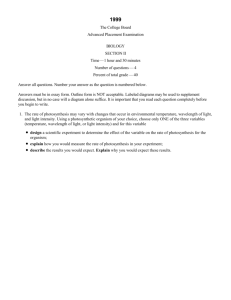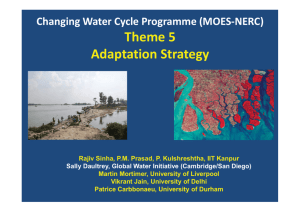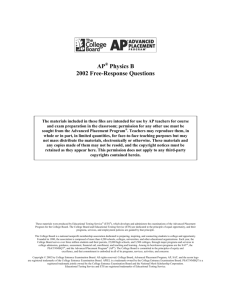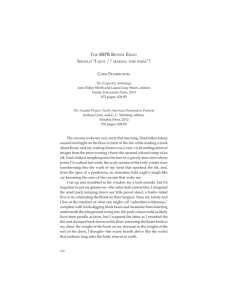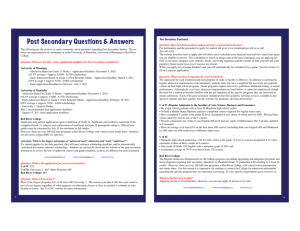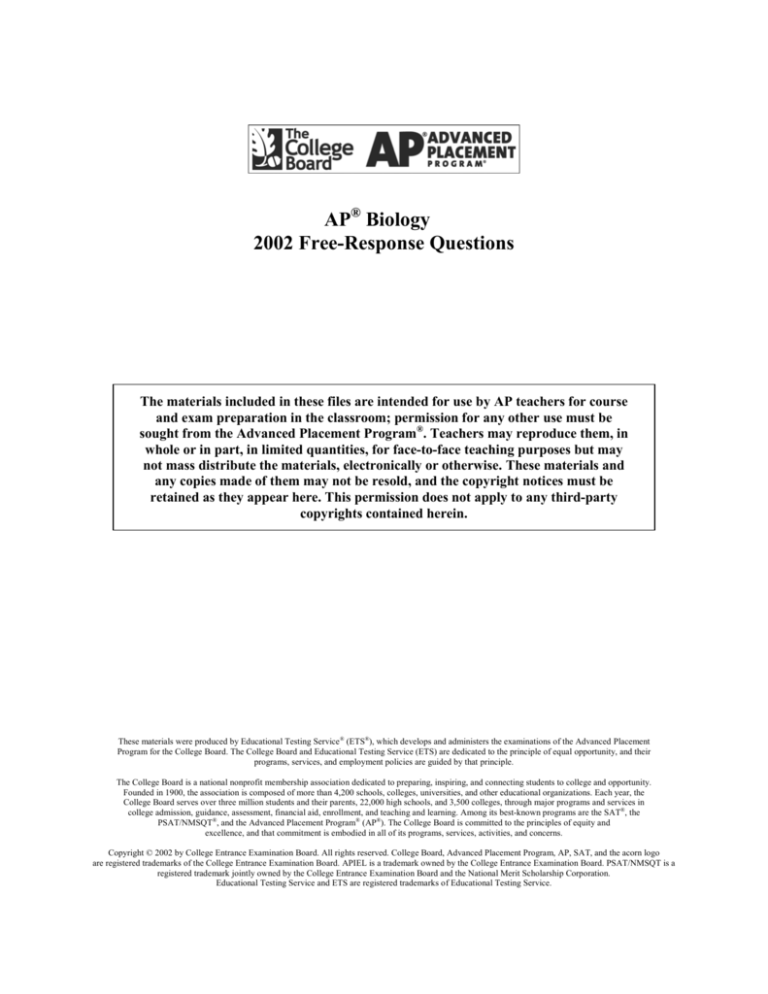
$3Biology
)UHH5HVSRQVH4XHVWLRQV
7KHPDWHULDOVLQFOXGHGLQWKHVHILOHVDUHLQWHQGHGIRUXVHE\$3WHDFKHUVIRUFRXUVH
DQGH[DPSUHSDUDWLRQLQWKHFODVVURRPSHUPLVVLRQIRUDQ\RWKHUXVHPXVWEH
VRXJKWIURPWKH$GYDQFHG3ODFHPHQW3URJUDP7HDFKHUVPD\UHSURGXFHWKHPLQ
ZKROHRULQSDUWLQOLPLWHGTXDQWLWLHVIRUIDFHWRIDFHWHDFKLQJSXUSRVHVEXWPD\
QRWPDVVGLVWULEXWHWKHPDWHULDOVHOHFWURQLFDOO\RURWKHUZLVH7KHVHPDWHULDOVDQG
DQ\FRSLHVPDGHRIWKHPPD\QRWEHUHVROGDQGWKHFRS\ULJKWQRWLFHVPXVWEH
UHWDLQHGDVWKH\DSSHDUKHUH7KLVSHUPLVVLRQGRHVQRWDSSO\WRDQ\WKLUGSDUW\
FRS\ULJKWVFRQWDLQHGKHUHLQ
7KHVHPDWHULDOVZHUHSURGXFHGE\(GXFDWLRQDO7HVWLQJ6HUYLFH (76ZKLFKGHYHORSVDQGDGPLQLVWHUVWKHH[DPLQDWLRQVRIWKH$GYDQFHG3ODFHPHQW
3URJUDPIRUWKH&ROOHJH%RDUG7KH&ROOHJH%RDUGDQG(GXFDWLRQDO7HVWLQJ6HUYLFH(76DUHGHGLFDWHGWRWKHSULQFLSOHRIHTXDORSSRUWXQLW\DQGWKHLU
SURJUDPVVHUYLFHVDQGHPSOR\PHQWSROLFLHVDUHJXLGHGE\WKDWSULQFLSOH
7KH&ROOHJH%RDUGLVDQDWLRQDOQRQSURILWPHPEHUVKLSDVVRFLDWLRQGHGLFDWHGWRSUHSDULQJLQVSLULQJDQGFRQQHFWLQJVWXGHQWVWRFROOHJHDQGRSSRUWXQLW\
)RXQGHGLQWKHDVVRFLDWLRQLVFRPSRVHGRIPRUHWKDQVFKRROVFROOHJHVXQLYHUVLWLHVDQGRWKHUHGXFDWLRQDORUJDQL]DWLRQV(DFK\HDUWKH
&ROOHJH%RDUGVHUYHVRYHUWKUHHPLOOLRQVWXGHQWVDQGWKHLUSDUHQWVKLJKVFKRROVDQGFROOHJHVWKURXJKPDMRUSURJUDPVDQGVHUYLFHVLQ
FROOHJHDGPLVVLRQJXLGDQFHDVVHVVPHQWILQDQFLDODLGHQUROOPHQWDQGWHDFKLQJDQGOHDUQLQJ$PRQJLWVEHVWNQRZQSURJUDPVDUHWKH6$7WKH
36$710647DQGWKH$GYDQFHG3ODFHPHQW3URJUDP$37KH&ROOHJH%RDUGLVFRPPLWWHGWRWKHSULQFLSOHVRIHTXLW\DQG
H[FHOOHQFHDQGWKDWFRPPLWPHQWLVHPERGLHGLQDOORILWVSURJUDPVVHUYLFHVDFWLYLWLHVDQGFRQFHUQV
&RS\ULJKWE\&ROOHJH(QWUDQFH([DPLQDWLRQ%RDUG$OOULJKWVUHVHUYHG&ROOHJH%RDUG$GYDQFHG3ODFHPHQW3URJUDP$36$7DQGWKHDFRUQORJR
DUHUHJLVWHUHGWUDGHPDUNVRIWKH&ROOHJH(QWUDQFH([DPLQDWLRQ%RDUG$3,(/LVDWUDGHPDUNRZQHGE\WKH&ROOHJH(QWUDQFH([DPLQDWLRQ%RDUG36$710647LVD
UHJLVWHUHGWUDGHPDUNMRLQWO\RZQHGE\WKH&ROOHJH(QWUDQFH([DPLQDWLRQ%RDUGDQGWKH1DWLRQDO0HULW6FKRODUVKLS&RUSRUDWLRQ
(GXFDWLRQDO7HVWLQJ6HUYLFHDQG(76DUHUHJLVWHUHGWUDGHPDUNVRI(GXFDWLRQDO7HVWLQJ6HUYLFH
2002 AP® BIOLOGY FREE-RESPONSE QUESTIONS
BIOLOGY
SECTION II
Time—1 hour and 30 minutes
Directions: Answer all questions.
Answers must be in essay form. Outline form is not acceptable. Labeled diagrams may be used to supplement
discussion, but in no case will a diagram alone suffice. It is important that you read each question completely before
you begin to write. Write all your answers on the pages following the questions in this booklet.
1. The human genome illustrates both continuity and change.
(a) Describe the essential features of two of the procedures/techniques below. For each of the procedures/
techniques you describe, explain how its application contributes to understanding genetics.
The use of a bacterial plasmid to clone and sequence a human gene
Polymerase chain reaction (PCR)
Restriction fragment length polymorphism (RFLP) analysis
(b) All humans are nearly identical genetically in coding sequences and have many proteins that are identical
in structure and function. Nevertheless, each human has a unique DNA fingerprint. Explain this apparent
contradiction.
Copyright © 2002 by College Entrance Examination Board. All rights reserved.
Advanced Placement Program and AP are registered trademarks of the College Entrance Examination Board.
2
GO ON TO THE NEXT PAGE.
2002 AP® BIOLOGY FREE-RESPONSE QUESTIONS
2. The activities of organisms change at regular time intervals. These changes are called biological rhythms. The
graph depicts the activity cycle over a 48-hour period for a fictional group of mammals called pointy-eared
bombats, found on an isolated island in the temperate zone.
(a) Describe the cycle of activity for the bombats. Discuss how three of the following factors might affect the
physiology and/or behavior of the bombats to result in this pattern of activity.
temperature
food availability
presence of predators
social behavior
(b) Propose a hypothesis regarding the effect of light on the cycle of activity in bombats. Describe a controlled
experiment that could be performed to test this hypothesis, and the results you would expect.
3. The complexity of structure and function varies widely across the animal kingdom. Despite this variation,
animals exhibit common processes. These include the following.
transport of materials
response to stimuli
gas exchange
locomotion
(a) Choose two of the processes above and for each, describe the relevant structures and how they function
to accomplish the process in the following phyla.
Cnidaria (e.g., hydra, jellyfish)
Annelida (e.g., earthworm)
Chordata (e.g., mouse)
(b) Explain the adaptive (evolutionary) value(s) of the structural examples you described in part a.
Copyright © 2002 by College Entrance Examination Board. All rights reserved.
Advanced Placement Program and AP are registered trademarks of the College Entrance Examination Board.
3
GO ON TO THE NEXT PAGE.
2002 AP® BIOLOGY FREE-RESPONSE QUESTIONS
4. The following experiment was designed to test whether different concentration gradients affect the rate of
diffusion. In this experiment, four solutions (0% NaCl, 1% NaCl, 5% NaCl , and 10% NaCl) were tested under
identical conditions. Fifteen milliliters (mL) of 0% NaCl were put into a bag formed of dialysis tubing that is
permeable to Na+, Cl-, and water. The same was done for each NaCl solution. Each bag was submerged in a
separate beaker containing 300 mL of distilled water. The concentration of NaCl in mg/L in the water outside
each bag was measured at 40-second intervals. The results from the 5% bag are shown in the table below.
CONCENTRATION IN mg/L OF NaCl OUTSIDE THE 5% NaCl BAG
Time
(seconds)
NaCl
(mg/L)
0
0
40
80
120
160
130
220
320
400
(a) On the axes provided, graph the data for the 5% NaCl solution.
(b) Using the same set of axes, draw and label three additional lines representing the results that you would
predict for the 0% NaCl, 1% NaCl, and 10% NaCl solutions. Explain your predictions.
(c) Farmlands located near coastal regions are being threatened by encroaching seawater seeping into the soil.
In terms of water movement into or out of plant cells, explain why seawater could decrease crop production.
Include a discussion of water potential in your answer.
END OF EXAMINATION
Copyright © 2002 by College Entrance Examination Board. All rights reserved.
Advanced Placement Program and AP are registered trademarks of the College Entrance Examination Board.
4

